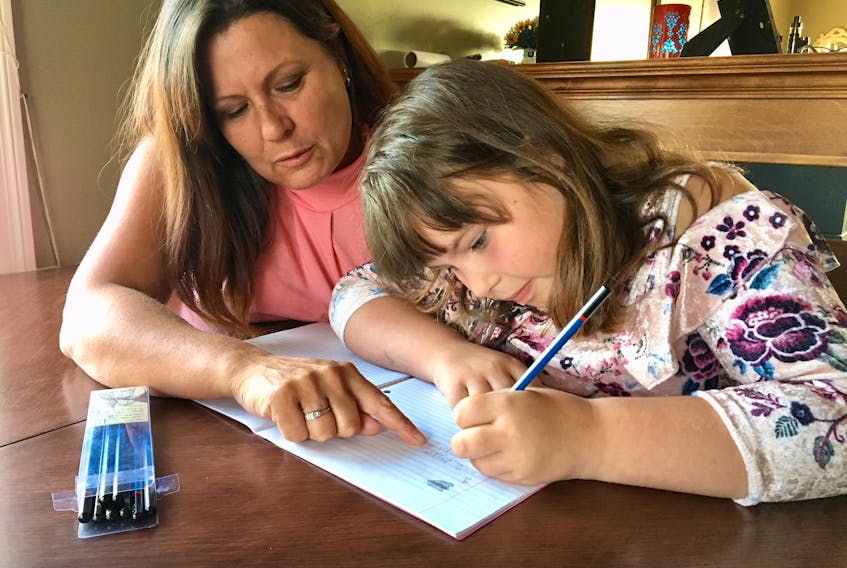After eating supper at a local restaurant, a group of customers heads to the cash to pay for their meal.
One of them hands the 18-year-old woman behind the counter their bill, which included their waitress’s neatly handwritten list of their food order.
With a puzzled look, the teenager stares at the piece of paper until she finally says, “I’m sorry, I can’t make this out. I’ll have to get your waitress.”
Confused, the customer asks why she couldn’t make out such legible notes.
“It’s in (hand)writing,” the young woman replies. “I can’t read writing. We didn’t do it in school.”
It’s not a rare occurrence.
The restaurant employee is one of many young people who are finishing high school in Newfoundland and Labrador without the knowledge of cursive writing.
It’s because cursive writing instruction is no longer emphasized in schools. In an age of technology in which this generation seems to only require keyboard and texting abilities, cursive writing, it seems, has gone the way of cassette tapes.
“It’s ridiculous,” said Shilo Stagg, whose eight-year-old daughter Lexie attends Grade 3 at Octagon Pond Elementary. “I teach Lexie how to write myself, but a few people I know think it’s a waste of time. I don’t think it’s a waste of time. I think it will be useful for her and I can’t believe the schools don’t teach it anymore.”

According to the province’s Department of Education, cursive writing instruction was never a mandatory part of the English language arts curriculum in the province.
“The Department of Education (and Early Childhood Development) never, ever authorized a resource for the teaching of cursive writing,” assistant deputy minister Elizabeth Churchill said. The instruction students received in previous years was school-driven and was often a focus of teachers.
“So, if a school did it, they did it based on their own school development plan of writing and they ordered the resource.”
Currently, cursive writing is one of the “suggested” ways to publish and share writing at the Grade 3 level, according to the department.
“The focus is not on one’s ability to write in a prescribed, cursive manner, but rather on legibility,” Churchill said.
“It is acceptable if a student prefers to use printing rather than cursive writing as a legible form of penmanship. Students who experience difficulties with manual dexterity may be supported with assistive technology devices.”
That explanation doesn’t sit well with some other people who feel young people are being shortchanged by not being taught the skill.
“It’s a tragedy,” retired teacher Philip (Bud) Thorne said of the loss of cursive writing instruction in schools.
Thorne hasn’t been in a school classroom since 1996, but runs Behind the Wheel Driving School in St. John’s and has seen first-hand the effects of cursive writing having been eliminated in the school system.
“When the kids get their licence and go to motor vehicle registration to get their photos taken, they can’t even sign their name. Can’t sign their name!” he said.
“It makes me sick!”
Newfoundland is one of the few in Canada where cursive writing is not a mandatory part of the curriculum.
Like Newfoundland and Labrador, instruction in cursive writing is introduced to children, but is not mandatory in British Columbia and Ontario.
Seven other provinces — Alberta, Saskatchewan, Manitoba, Quebec, New Brunswick, Nova Scotia and Prince Edward Island — have cursive writing instruction as a mandatory requirement in their curricula, usually in Grades 3 to 6.
“Instruction in cursive writing begins in Grade 3. Instruction and practice continue in Grade 4 and are reinforced and practised in Grades 5 and 6 in order for automaticity to occur,” wrote P.E.I.’s Education department’s senior communications officer, Jean Doherty, in response to The Telegram.
Thorne, who taught for 30 years at Gonzaga and Holy Heart high schools in St. John’s, describes cursive writing as a lost art.
“Maybe it’s one of those things where I’m so old-fashioned, but I still believe kids should know how to (hand)write. … Handwriting is everywhere in the world today and is still valuable.”
Wading in
Want to wade into the debate? Write a letter to the editor and email it to [email protected]. Be sure to include a name, address and daytime telephone number where the author can be contacted. Letters should be no more than 250 words.









